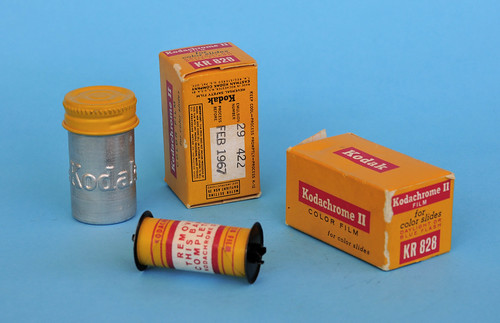Difference between revisions of "828 film"
(noted Kodak's rationale of larger image size; added history link) |
(added another photo w/packaging) |
||
| Line 1: | Line 1: | ||
{{Flickr_image | {{Flickr_image | ||
| − | |image_source= http://www.flickr.com/photos/ | + | |image_source= http://www.flickr.com/photos/heritagefutures/4294715169/in/pool-camerawiki |
| − | |image=http:// | + | |image= http://farm5.static.flickr.com/4033/4294715169_a88fc875f6.jpg |
|image_align= right | |image_align= right | ||
| − | |image_text= 828 | + | |image_text= 828 Kodachrome II packaging |
| + | |image_by= Dirk HR Spennemann | ||
| + | |image_rights= with permission | ||
}} | }} | ||
| − | '''828''' film was [[Kodak]]'s unperforated 35mm paper-backed [[rollfilm|roll film]], introduced in 1935. The image size of [[35mm|standard 35mm film]] was considered "miniature" in the 1930s; but by eliminating the sprocket holes (a vestige of 35mm film's movie origins) Kodak could increase 828's image area by 30% (to 28x40mm). A smaller diameter spool allowed for smaller camera designs as well. [[Kodak Bantam | Kodak's Bantam]] camera series used 828 film. | + | '''828''' film was [[Kodak]]'s unperforated 35mm paper-backed [[rollfilm|roll film]], introduced in 1935. The image size of [[35mm|standard 35mm film]] was considered "miniature" in the 1930s; but by eliminating the sprocket holes (a vestige of 35mm film's movie origins) Kodak could increase 828's image area by 30% (to 28x40mm). A smaller diameter spool allowed for smaller camera designs as well. [[Kodak Bantam | Kodak's Bantam]] camera series used 828 film, and so the size is often known by the "Bantam" name. |
Other paper-backed 35mm film formats have included [[Bolta film|Bolta]] and the film [[Konica|Konishiroku]] produced for the [[Konilette]]. | Other paper-backed 35mm film formats have included [[Bolta film|Bolta]] and the film [[Konica|Konishiroku]] produced for the [[Konilette]]. | ||
| Line 14: | Line 16: | ||
*[http://nelsonfoto.com/SMF/index.php/topic,1600.0.html "Feeding a classic"] (a thread at [http://nelsonfoto.com/SMF/index.php Nelsonfoto forums]), about using cut-down 120 film | *[http://nelsonfoto.com/SMF/index.php/topic,1600.0.html "Feeding a classic"] (a thread at [http://nelsonfoto.com/SMF/index.php Nelsonfoto forums]), about using cut-down 120 film | ||
| + | {{br}} | ||
| + | {{Flickr_image | ||
| + | |image_source= http://www.flickr.com/photos/24225011@N04/2468725502/in/pool-camerapedia/ | ||
| + | |image=http://farm3.static.flickr.com/2216/2468725502_1562643c3c_o.jpg | ||
| + | |image_align= left | ||
| + | |image_text= 828 film spool compared<br>to modern 35mm cassette | ||
| + | }} | ||
[[Category:film formats]] | [[Category:film formats]] | ||
[[Category:828 film]] | [[Category:828 film]] | ||
Revision as of 17:19, 20 March 2011

|
| 828 Kodachrome II packaging image by Dirk HR Spennemann (Image rights) |
828 film was Kodak's unperforated 35mm paper-backed roll film, introduced in 1935. The image size of standard 35mm film was considered "miniature" in the 1930s; but by eliminating the sprocket holes (a vestige of 35mm film's movie origins) Kodak could increase 828's image area by 30% (to 28x40mm). A smaller diameter spool allowed for smaller camera designs as well. Kodak's Bantam camera series used 828 film, and so the size is often known by the "Bantam" name.
Other paper-backed 35mm film formats have included Bolta and the film Konishiroku produced for the Konilette.
Links
- Kodak Bantam Special including a history of 828, by Brian Wallen
- Kodak 828 Film replacement options by Brian Wallen
- "Feeding a classic" (a thread at Nelsonfoto forums), about using cut-down 120 film

|
| 828 film spool compared to modern 35mm cassette |